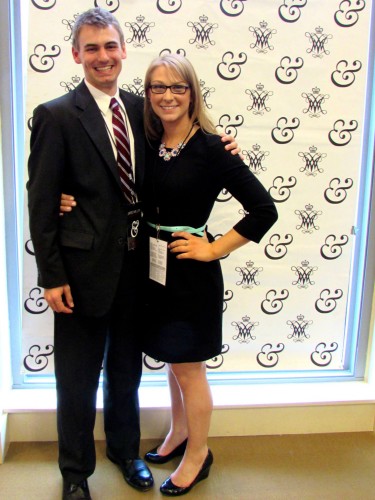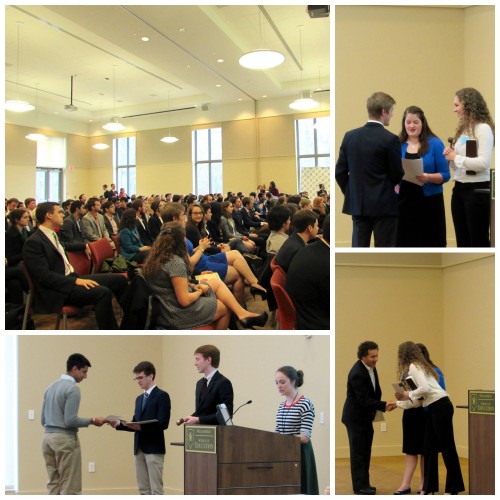Situated a stone’s throw away from Colonial Williamsburg, the College of William & Mary seems the perfect place to play pretend. As pseudo-colonials swanned about in coquettish attire recreating the ambience of our nation’s many-splendored past, a host of dedicated William & Mary students donned costumes of their own. Their mission, in keeping with the spirit of Williamsburg, was to use the past and imagined realities to teach lessons for the future through the the medium of Model United Nations. From March 27-30, 2014, William & Mary hosted the second iteration of &MUN, bringing together delegates from universities across the nation to participate in six small, crisis-driven committees. As a fledgling conference, &MUN offers delegates and staff alike a great forum for learning and growth, and Best Delegate had the opportunity to witness the events of the weekend unfold firsthand.
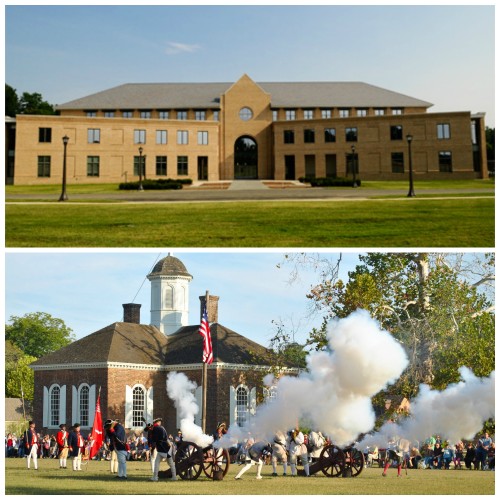
At the crossroads of Modern & Traditional: The William & Mary School of Education, where &MUN II was held (top) and history in action at Colonial Williamsburg (bottom).
From the outset, it was apparent that &MUN is unique in several aspects independent of its novelty, such as its commitment to personalizing the conference experience for delegates and to “reactivity,” a motif throughout this year’s conference. In an effort to create more of a community, the conference deviated from the traditional Thursday evening conference schedule of opening ceremonies followed by the first committee session, opting instead for committee dinners to give delegates the opportunity to get to know their fellow committee members and chairs in an informal setting before the competition kicked off. This set-up also solves the oft-overlooked logistical unpleasantry of delegates struggling to bring their A-game to the conference’s first session while exhausted from what is often an entire day or more of travelling to get to the conference. With &MUN’s schedule, delegates can relax for the first night, get a feel for the conference venue and the people in their committee, and start committee session on Friday morning (hopefully) well-rested and better prepared.
Before delegates broke off into their individual committees, opening ceremonies keynote speaker, Patrick N. Theros, former U.S. Ambassador to Qatar, set the stage for a weekend of diplomatic debate. Calling diplomacy the “second oldest profession,” he discussed with delegates the skills and virtues a good diplomat must have, citing flexibility, focus, physical courage, and the ability to “learn from [your] background without letting it define [you]” as qualities integral to the profession. Theros also described the mindset necessary for the field, saying, “The question is never, ‘If I were a Russian, what would I do?’; it is ‘What will Russia do? Pursuing US policy requires that you know and understand the actual sources of policy in other states.” The speech concluded with a question and answer session in which Theros also gave delegates personal insight into what they could expect from a career in diplomacy. “Good diplomats are like good light infantry,” he imparted, “You push and you probe, you push and you probe, and hopefully you accomplish your mission.”
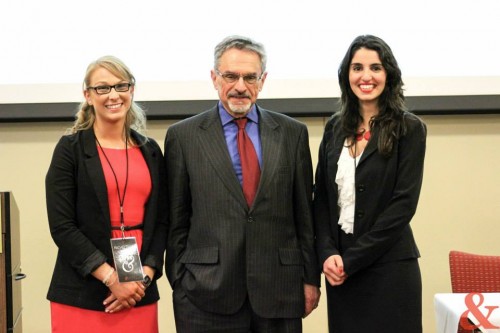
Ambassador Patrick Theros with Secretary-General Rachel Fybel (left) and Director of External Relations Alexcia Chambers (right). (Photo Credit to Harini Manikandan, Molly Menickelly, and Carly Lin of &MUN.)
Over the next several committee sessions, delegates did just that, trying every diplomatic move in their playbook to succeed at their various missions in committee. And on the other side of the committee doors, the &MUN staff worked tirelessly to make the experience as realistic and interesting as possible for the delegates. Having served on the secretariat of &MUN I as the Director of External Relations, &MUN II Secretary-General Rachel Fybel came into the role of Secretary-General fully understanding the importance of creating a great delegate experience, particularly for a young conference. In a rare moment of downtime, Fybel gave Best Delegate some insight into the driving vision behind &MUN, emphasizing its dichotomous nature. “We think of the ampersand as a connective evocative of the dual nature of &MUN,” she explained, “History & Innovation, Modern & Traditional; &MUN synthesizes these qualities into a conference that strives to provide the best of both worlds.” Taking the lead on such an ambitious endeavor is no picnic, though. In fact, Fybel jokingly compared the build-up to &MUN to her future wedding day, complete with rehearsals, nerves, and emotions gone wild. She has great pride in the dedication of her staffers and the enthusiasm of her delegates, and it shows.
The &MUN II secretariat and staff, who had been “hand-selected for greatness,” certainly went above and beyond to ensure that &MUN delivered on both the historical and innovative fronts. A quick peek into the staff headquarters revealed a large number of enthusiastic, energetic staff ready for crisis action as they stood equipped with the latest gadgets and gizmos and what looked like half of Party City or the drama department’s prop collection. At the front of the room directing operations (and sporting hats from the crisis stash) were Collin Jones and Eleanor Trott, the Under Secretary-Generals for Committees and for Simulations, respectively. Best Delegate had the opportunity to chat with both Trott and Jones to learn more about the unique committee structure of &MUN, in between the execution of various crises, of course.
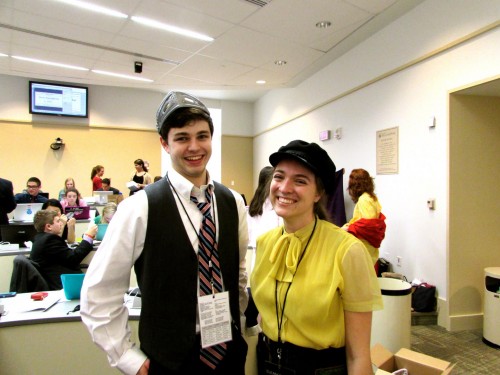
Under Secretaries-General Collin Jones (left) and Eleanor Trott (right) pose in crisis gear at the &MUN staff headquarters.
Jumping on the trend across the American Model UN circuit towards crisis rather than General Assemblies, &MUN has joined the small handful of conferences that are comprised exclusively of crisis committees (WPMUNI and VICS being other examples). Jones, who had served as a crisis director for the UNSC at &MUN I, explained that, while there were no GAs, the selection of committees at &MUN II had been consciously crafted to provide a healthy mix of historical and future-thinking formats, as well as governmental and UN bodies. This mix is evident in the committees offered, namely the “Committee for the Re-Election of the President, 1971,” “Paralyzing the Asymmetrical Threat: United States National Security Council,” the “Shanghai Cooperation Organization,” the “United Nations Security Council,” “With This Shield or On It: Gerousia, 480 B.C.,” and the “Ad-Hoc Committee of the Secretary-General.” Jones stepped into the role of USG for Committees armed with a wealth of experience from competing in various committees as a delegate himself, having been on the circuit since 7th grade. In the lead-up to &MUN II, he worked with the committee chairs and crisis directors to come up with a crisis framework with one “main branch,” as well as side notes and alternatives, with the ultimate goal of being “reactive” to the course of events in the committee.
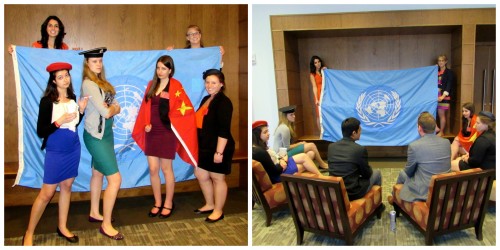
Crisis in action: &MUN staffers take on the roles of representatives from the P5 countries and simulate a meeting at the UN for two delegates from the USNSC.
Trott, who served as the USG for Crisis for the first round of &MUN, elaborated upon this goal of “reactivity,” saying that it meant the ability to react rapidly and effectively to the unfolding of events in the crisis committees, as well as to feedback from delegates. As this year’s &MUN attracted three times more delegates than the first round, with 139 of the registered 150 delegates attending, she stressed that this flexibility was crucial, as there were many challenges and differences to adapt to with the expanded conference size. Unlike Jones, Trott, who is a Geology and Art student at the College, actually does not compete on the circuit, and thus brings a balance of perspective to the team. She identified the technological aspect as one of the defining features of the &MUN crisis model, saying that they had reserved “half the media center” for use during the conference. The equipment, like the School of Education (built only in 2010) in which the conference was held, was all state-of-the-art technology, and helped facilitate the speed at which the staffers got updates together, as well as the quality of the finished products. To further facilitate communication between delegates and crisis staffers, the crisis directors in each committee would gather all delegate notes in a box, which a member of staff would periodically pick up and bring to the crisis staff HQ for response and execution. Both Jones and Trott expressed the pride they felt in seeing how quickly the &MUN staff was able to respond to and fix any problems, and how the delegates were having a good time in their sessions. “I hope delegates walk away with a unique experience and having learned a lot from their individual committees…and that they come back for &MUN III!” Jones added.
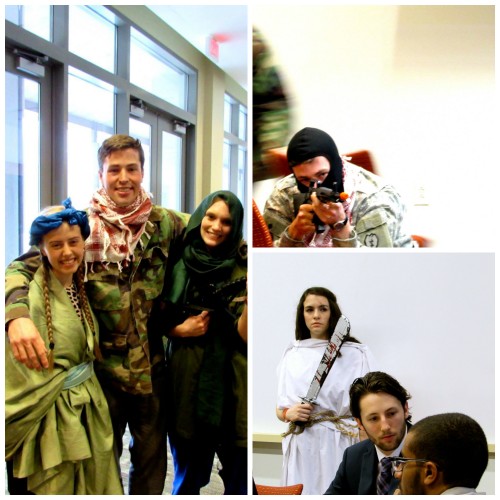
Lights, camera, (re)action! The crisis staff don their gear to simulate realistic crises for the committees.
One committee sure to leave delegates with a unique experience was &MUN II’s Ad-Hoc, chaired by Connor Smith. Smith was the Secretary-General for &MUN I, and has thus seen the conference from multiple perspectives. Smith shared with us the vision behind Ad-Hoc, which centered on Transnistria, a Moldovan de facto state bordering the Ukraine. “My goal for Ad-Hoc this year was to stay as true to the unique dynamics of this type of committee as humanly possible,” he explained. “To this end, we did not reveal our topic until delegates walked into the first committee session, and they picked their positions as they entered the room. We had four cryptic clues attached to emails in the week leading up to the conference, and listening to how the delegates interpreted them was one of my favorite parts of the weekend. These were important to make sure they acquired a bit of background about the regional context without figuring out the topic itself.”
As every delegate who has ever been in an Ad-Hoc knows, the arrangement of Ad-Hocs as “blind” committees, where delegates know virtually no information about their position and are thus unable to research beforehand, makes preparation extraordinarily difficult. &MUN II’s Ad-Hoc strove to alleviate some of the burden on delegates. “It was extraordinarily challenging to make sure that the delegates had enough information for informed debate,” Smith acknowledged, “Given that the topic of de facto states and Transnistria is rather obscure, we put a lot of time into creating colorful back-stories for our positions and distilling the unique post-conflict dynamic of the region into digestible briefs. We also invited a William & Mary faculty member specializing on Eurasian statebuilding to answer questions before delegates began debate to make sure they nailed down the dynamics of the problem (and the committee) before we pressed play.”
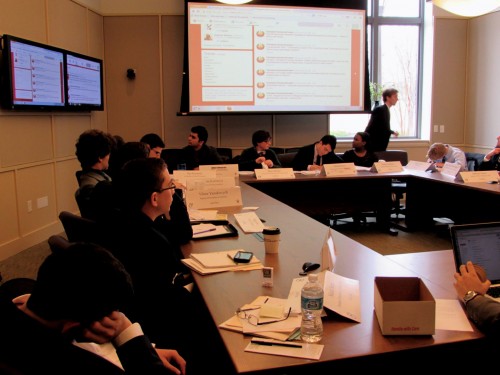
Teched-up: Delegates in Ad-Hoc monitor the live Twitter feed and updates projected onto the screens in the committee room.
This Ad-Hoc was also unique in its use of heavily-integrated technology and non-traditional formats of debate. “Once we were in the thick of debate, we had set up a TV to display a perpetual Twitter feed that reacted to crisis notes in real-time and we displayed print and video updates about 5 or 6 times per hour,” Smith described. “When we had NATO breathing down our neck in the West and, after a contentious referendum, we voted to join the Russian Federation, we ran a high-pressure war-game for a single session, in which delegates had 10-minute cycles to approve committee directives regarding troop movement and military strategy. This was designed to ensure that no one could simply do battle on the basis of position powers, and I certainly hope it made the classic crisis war-game a more engaging in-room experience. Basically, we just ran the committee I always wanted to be in, and I really just hope our delegates had half as much fun as I did.”

Connor Smith, Secretary-General of &MUN I and Director of the Ad-Hoc Committee for &MUN II, presents the awards for his committee at Closing Ceremonies.
Outside of committee, &MUN II also provided delegates with opportunities to experience the Williamsburg “college town” social scene, in the form of cutely-named events &Chill (a bar crawl) on Friday and &Rage (the delegate social) on Saturday. All in all, it appeared that the goal of bringing a personal touch to the conference was a success. As the last committee session wound to a close, Best Delegate caught up with delegate Elena Stephenson, Stanford Class of 2014, who had the privilege of attending &MUN as a delegate for both years it has been in existence. She described for us what drew her to the conference, saying, “&MUN has, in just two years, become one of my favorite conferences on the circuit for several reasons: first and foremost, it’s very well staffed, leading to extremely quick response times for crisis notes. Crisis in general at &MUN is excellent; the staffers seem excited to deliver each update in various inventive accents and costumes; the updates are frequent and detailed, following a cohesive plan but also allowing delegates plenty of freedom to shape the storyline through their own actions. &MUN also stands out for the incredible friendliness and approachability of their staff, who are able to both be professional and highly competent and make each delegate quickly feel part of a community.”
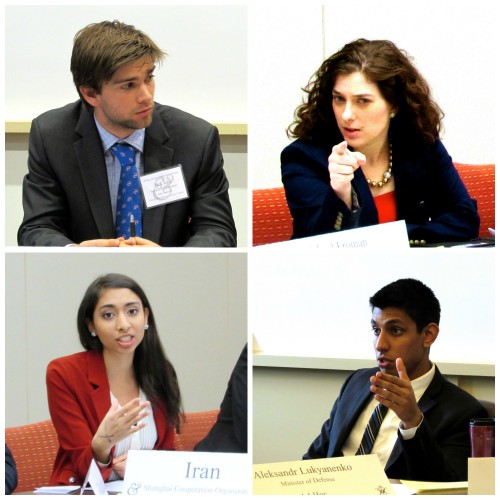
Up close and personal: Delegates “in the zone” as they engage in deep debate and discussion during their committee sessions.
The community feeling was particularly palpable at closing ceremonies, where the secretariat expressed their heartfelt thanks to each other, the staff, and the delegates for all of the hard work that went into the making of &MUN, both the first and second iterations. Summarizing for us what made &MUN so special, Fybel said, “You can discuss global issues in the classroom, in your papers, or at lunch with your friends, but you don’t always have the opportunity to engage with individuals with similar backgrounds yet different views like this. &MUN provides delegates with this exposure to different perspectives and the opportunity for growth. And when delegates grow, &MUN grows.”
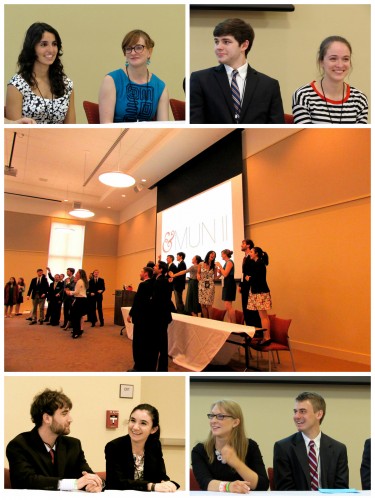
The Secretariat lead the crowd in a rousing chorus of the W&M fight song as they celebrate the close of &MUN II.
Congratulations to the &MUN II staff and delegates on a second conference well done, and Best Delegate wishes you all the best as you continue to grow as a conference in the lead-up to &MUN III!
Awards
Congratulations go to the following schools on their delegation awards:
Best Delegation: George Washington University
Outstanding Delegation: Duke University
Special Thanks
Best Delegate would like to thank the &MUN II secretariat and staff for welcoming us to the William & Mary campus and for giving us an insider’s view of the conference. Special thanks go to secretariat members Rachel Fybel, Jared Miller, Collin Jones, Eleanor Trott, Casey Welsh, Alexcia Chambers, Scott Shapses, and Leena Al-Souki. Thanks also to Alex Richard of Stanford University for his assistance with opening ceremonies coverage, and Elena Stephenson for providing a delegate’s perspective on &MUN for Best Delegate.
*Unless otherwise noted, photos belong to the author.
In the spirit of the ampersand, we have written a two-part feature inspired by the creation of &MUN and other new conferences springing up on the circuit. Click here to read our article on conference planning with exclusive interviews with &MUN alum!


